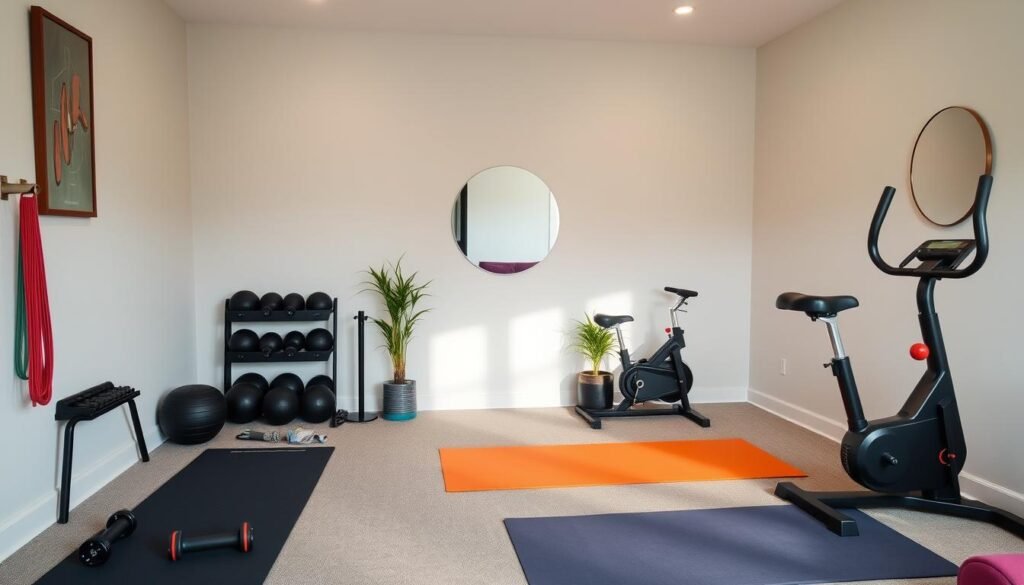The Association for Size Diversity and Health promotes “Health at Every Size.” This idea focuses on health, not just weight. It’s important because being overweight can lead to serious health issues like diabetes and heart disease.
Starting a weight loss journey can feel overwhelming. It’s easy to get caught up in strict routines and goals. But, it’s key to remember that being flexible and adaptable is just as important.
In this article, we’ll show you how to make weight loss routines that fit you perfectly. We’ll talk about overcoming obstacles and finding a path that works for you.
Key Takeaways
- Understand the psychological barriers that can hinder weight loss efforts and how to overcome them
- Discover the science behind sustainable habit formation and how to start small
- Explore the role of your body’s biology in the weight loss journey and how to work with it
- Create a personalized fitness framework that adapts to your changing needs
- Build confidence through progressive achievement and mindful exercise
- Integrate sustainable lifestyle strategies to maintain long-term success
Understanding the Psychology Behind Weight Loss Intimidation
Starting a weight loss journey can feel scary for many. The fear of beginning and past failures can block progress. It’s key to understand the psychological reasons behind this fear to move forward.
Fear of Starting and Past Experiences
Many feel nervous about starting a new fitness plan or changing their lifestyle. Past failures can make them doubt themselves. But, knowing these feelings are common and learning from past attempts can help.
Internal vs. External Value Systems
How we see our worth affects our ability to face weight loss challenges. Those with an internal locus of values make choices based on their own needs. On the other hand, people-pleasers with an external locus of values often struggle to find lasting success.
Breaking Free from Mental Barriers
Identifying the psychological routines, habitual patterns, and behavioral cycles that hold us back is the first step. By changing our mindset and focusing on our own goals, we can overcome these barriers.
To beat weight loss intimidation, we must understand the psychological reasons. By facing our fears, recognizing our value systems, and breaking free from mental blocks, we can start our journey with confidence and success.
Starting Small: The Science of Sustainable Habits
Building good habits is key to lasting success in weight loss and wellness. Studies show that focusing on one small habit at a time boosts success rates to 70% or more. This is much higher than trying to change many things at once, which only works for 5% of people.
This method, called the flexibility mindset, makes the journey longer but more natural. It helps you focus on the journey, not just the end goal. This way, you’re more likely to succeed and feel less stressed. Even though it might not be as thrilling as big changes, it’s a smart and effective way to make lasting changes.
The science behind this method is based on structured improvisation. It lets you adjust and improve your habits as you go. This means you can make your habits fit your life better, not the other way around. It’s a flexible way to build habits that really work for you.
“The key to successful habit formation is to start small and celebrate every win, no matter how seemingly insignificant,” explains Dr. Kyra Bobinet, a renowned expert in evidence-based habit design. “It’s about progress, not perfection.”
By adopting this habit formation mindset, you can start a weight loss journey that’s both achievable and fulfilling. Remember, slow and steady wins the race to lasting success.
The Role of Body Biology in Weight Loss Journey
Starting your weight loss journey means understanding your body’s role. Hormones, natural responses, and physical changes all affect your progress. Knowing these factors helps you find better ways to lose weight that fit you.
Hormonal Influences on Weight Management
Hormones like ghrelin and leptin control your hunger and metabolism. When you eat less, ghrelin goes up, making you hungrier. Leptin goes down, making you feel less full. Knowing this helps you deal with hunger and fullness signals.
Understanding Your Body’s Natural Responses
Sometimes, your body tries to protect itself from losing too much weight. It has a natural weight range it wants to keep. Understanding this helps you work with your body, not against it, for better weight management.
Physical Adaptation Process
When you lose weight, your body changes. Your metabolism slows down, and you use energy more efficiently. Knowing this helps you adjust your plan to keep losing weight.
Dealing with weight loss biology is complex, but doable. With the right knowledge, you can beat the challenges and reach your goals. By understanding hormones, natural responses, and physical changes, you can make a plan that fits your body.
Creating a Personalized Fitness Framework
Creating a personalized fitness plan is key for losing weight. It’s about knowing your fitness level, lifestyle, and what you like. This way, you can set goals that feel real and fit into your life easily.
Your fitness plan should be flexible and change with your life. Being able to adjust to new schedules or places is important. It helps you stay on track and deal with adaptability challenges in dynamic environments.
To make your fitness plan, start with SMART goals. These are specific, measurable, achievable, relevant, and timely. You can have both short-term and long-term goals. Make sure they match your values and keep you motivated.
| Goal Type | Description | Example |
|---|---|---|
| Short-term | Achievable within a shorter timeframe, such as by the end of the day, week, or month. | Increase daily step count by 2,000 steps within the next 2 weeks. |
| Long-term | The ultimate destination, encompassing positive lifestyle changes like gaining muscle or sustaining a nutritious diet. | Achieve a body fat percentage below 15% by my 30th birthday. |
| Mastery-based | Focus on gradual skill improvement and intrinsic fulfillment, not external validation. | Improve my squat form and technique over the next 6 months. |
| Behavior-based | Shift the focus from desired outcomes to actionable steps that can be controlled. | Incorporate 30 minutes of strength training into my routine 3 times per week. |
Your fitness plan should be flexible for life’s changes. Check and update your goals often to keep them right for you. With a plan that fits you, you’ll stay motivated and on track with your weight loss.

intimidating routines simply, routines change frequently, fixating aspect progra
Changing your routine is a normal part of getting healthier. As you get stronger and your goals change, your workouts might need to too. It’s okay to feel scared of these changes, but the trick is to keep some habits the same while adding new ones.
It’s important to mentally prepare for these changes. Instead of focusing on the end result, enjoy the journey. This way, you can handle changes better and find happiness in the process. Being open to change helps you stay consistent in your fitness journey.
Adapting to New Patterns
People with autism often like their routines to be the same. But, changing things can be hard. Knowing your habits and patterns helps you deal with the anxiety that comes with change.
- Keep the parts of your routine that make you feel safe and in control as you add new things.
- Try dialectical behavior therapy (DBT) to learn how to handle your emotions better during changes.
- Tell your friends and family about your need for control and set clear limits to feel secure during changes.
Maintaining Consistency Through Change
Even though you need to change your routine to keep improving, it’s key to stay consistent. Focus on the journey, not just the end goal. This helps you stay steady even when your routine shifts.
- Make sure the habits that help you succeed stay the same, even as your routine changes.
- Have plans for when things get disrupted, like having a special item or talking to your loved ones about stress.
- Be proud of your small wins and celebrate your progress, even when your routine changes.
Learning to accept and adapt to routine changes is key to lasting weight loss. By being mentally strong, adaptable, and focusing on the journey, you can smoothly move through these changes. This will help you keep going on your path to lasting change.
Building Confidence Through Progressive Achievement
Building confidence in fitness is a slow process. It’s about reaching small goals one at a time. Every small win boosts your confidence and keeps you motivated.
As you get more confident, it shows in more areas of your life. The idea of a growth mindset, started by Carol Dweck, has changed how we see challenges. It teaches us to see them as chances to grow. This mindset helps you see obstacles as ways to improve yourself.
But, self-doubt can hold you back. It can show up as wanting to be perfect, putting things off, or being too hard on yourself. Recognizing these patterns is the first step to beating them. Break down big goals into smaller ones and focus on positive thoughts to keep moving forward.
Having a supportive group around you can also help. For example, the author found comfort in a Discord group of lady lifters. They offered advice and encouragement. Taking care of yourself, like through meditation, also boosts your mental and physical health.
In the end, confidence in fitness comes from small wins. Each success, whether it’s learning a new exercise or reaching a personal record, adds to your sense of progressive achievement, confidence building, and mental conditioning. These benefits can improve your life in many ways.

“Fitness is not just about the physical; it’s a journey of mental conditioning and psychological routines that unlock your true progressive achievement.”
Mindfulness and Body Awareness in Exercise
Mindfulness and body awareness are key to a lasting fitness plan. By listening to your body’s signals, you can avoid injuries and burnout. Adding meditation to your fitness routine also cuts stress and boosts well-being.
Listening to Your Body’s Signals
It’s vital to tune into your body’s signs for safe and effective workouts. Notice feelings like muscle tiredness, joint pain, or breathing changes. Adjust your exercise to avoid overdoing it. This mindful way helps you challenge yourself without overstepping your limits.
Incorporating Meditation into Fitness
Adding meditation practices to your fitness can greatly benefit you. Research shows 5 minutes of mindful breathing can lower distress and heart rate in cancer patients. 20-minute sessions also help caregivers feel less stressed than just listening.
Mindfulness meditation strengthens the bond between your mind and body. It boosts your awareness of physical sensations and helps understand your body’s needs better. This connection is vital for lasting success in fitness and managing weight.
“Mindfulness is not just about stress reduction, but about enriching our lives, including fitness and sports performance.”
Sustainable Lifestyle Integration Strategies
Making fitness a part of your life is about creating habits that fit your daily routines. This way, moving your body becomes a natural part of your day, not a separate task. By adding physical activity and healthy choices to your daily life, you’ll stick to it better and see lasting results.
Start by looking for chances to integrate fitness into your lifestyle. This might mean taking short walks at work, choosing to walk or bike to places, or doing strength training while watching TV. The goal is to make fitness a seamless, enjoyable part of your daily life, not an extra burden.
Building sustainable habits is key for lasting success. Instead of changing everything at once, start with small, easy changes. Studies show this method can lead to a 70% success rate, compared to just 5% when trying to change too much at once.
Also, be open to routine flexibility and dynamic adjustments. As your life changes, so should your fitness routine. This might mean finding new ways to stay active or trying different workouts that fit your current needs and preferences.
The secret to lasting lifestyle changes is making fitness a natural, enjoyable part of your day. By starting small, staying flexible, and adjusting as needed, you can build a healthy lifestyle that supports your well-being.
| Sustainable Habit Strategies | Benefits |
|---|---|
| Focusing on one change at a time | Up to 70% success rate |
| Incorporating movement into daily routines | Seamless integration of fitness |
| Adapting to evolving life circumstances | Maintains consistency through change |
“The key to sustainable lifestyle integration is making fitness a natural, enjoyable part of your daily life.”
Conclusion
Overcoming intimidation in your sustainable weight loss and fitness journey is key. It’s about knowing your body, mind, and personal situation. Start small, focus on lifestyle changes, and add personalized fitness to your day. This way, you’ll find a path to lasting success.
The journey is not just about looking good. It’s also about growing mentally and improving your overall health. Be patient, celebrate small wins, and remember that your unique needs guide the best strategies for you.
Stay committed to healthy habits and listen to your body. This will empower you to take charge of your health. Trust that the benefits of your hard work will be worth any initial struggles.




